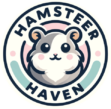Welcome to the enchanting world of dwarf hamsters, where tiny creatures brim with genetic intricacies that shape their lives in profound ways. These beloved pets, known for their small size and dynamic personalities, carry a wealth of genetic secrets waiting to be unlocked. This comprehensive guide delves into the genetic makeup of the Roborovski, Campbell’s, Winter White, and the Chinese hamster, each species offering unique insights into the interplay between genetics and pet care.
Introduction to Dwarf Hamster Genetics
Dwarf hamsters are not just adorable; their behaviors, health, and care needs are deeply rooted in their genetics. Understanding these genetic foundations is crucial for providing optimal care and enhancing their well-being:
-
- True Dwarf Species: Roborovski, Campbell’s, and Winter White hamsters are known for specific traits that are essential for their survival and social interaction.
-
- Quasi-Dwarf Species:The Chinese hamster, often included due to its small size, exhibits unique genetic traits that distinguish it from true dwarfs.
These small animals are equipped to thrive in their respective environments, and these adaptations significantly influence their care in captivity.
Decoding Genetic Traits: Roborovski Dwarf Hamster
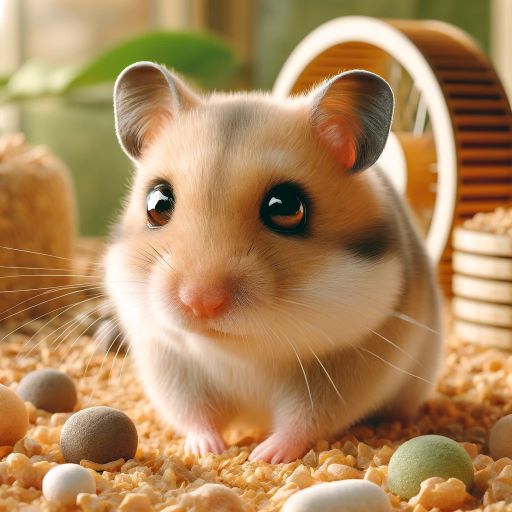
Originating from Central Asia’s deserts, the Roborovski dwarf hamster’s genetics are a testament to survival and agility:
-
- Physical Traits: They are the smallest of all species, with a typical size of about 2 inches in length.
-
- Desert Adaptations: Their sandy-brown coat provides camouflage from predators, crucial for their survival in the wild.
-
- Behavioral Traits: Known for their incredible speed and high energy levels.
-
- Optimal Habitat: Arid, minimal moisture setups with space to run.
-
- Temperature: They thrive at room temperatures around 65-75°F.
-
- Sociability: Least sociable towards human touch but enjoys companionship of other Roborovskis.
-
- Fun Fact: Roborovski hamsters can run over a hundred miles in a single night on their exercise wheel!
The Roborovski’s swift movements make them less ideal for handling but perfect for those who enjoy observing their energetic antics. Their need for space and exercise makes it essential to provide a habitat that allows them to exhibit their natural behaviors without restraint. Enthusiasts will find observing their complex behaviors and interactions within their habitat a fascinating experience, as their agility and speed are a marvel in the pet world.
Genetic Insights and Care: Campbell’s Dwarf Hamster

Campbell’s dwarf hamsters showcase a diverse genetic palette that affects both their appearance and temperament:
-
- Physical Traits: Slightly larger than Roborovskis, with more robust bodies.
-
- Coat Color Variation: Results from extensive selective breeding, offering a wide array of colors and patterns.
-
- Social and Health Implications: Their friendly demeanor can be overshadowed by a tendency to nip when threatened.
-
- Optimal Habitat: They require a habitat that allows for burrowing and nesting.
-
- Temperature: Best kept at temperatures between 65-75°F.
-
- Sociability: Moderately sociable, often enjoying human interaction.
-
- Fun Fact: Campbell’s dwarf hamsters have been known to recognize their owners’ voices and may come to the front of their cage when called by name.
Campbell’s hamsters are a favored choice for both novice and experienced owners. Their adaptability to various environments and the diversity of their coat colors make them particularly appealing. However, their propensity to nip requires owners to approach them with understanding and patience, particularly when socializing them for handling.
The Wintry World of Genetics: Winter White Dwarf Hamster
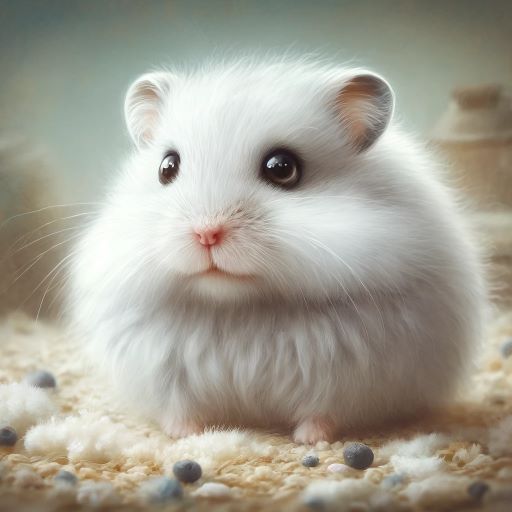
The Winter White dwarf hamster is renowned for its dramatic coat color changes:
-
- Physical Traits: Similar in size to Campbell’s but with the ability to change coat colors.
-
- Seasonal Coat Changes: Their fur changes from grey to white in winter conditions, a genetic adaptation for camouflage.
-
- Community Living: Genetically predisposed to thrive in communal settings.
-
- Optimal Habitat: Requires a cooler environment that mimics their natural, cold habitat.
-
- Temperature: Thrives in cooler conditions, ideally below 70°F.
-
- Sociability: The most sociable among the dwarf species, often seeking human touch.
-
- Fun Fact: Winter White hamsters can change their coat color in just a few weeks, depending on environmental cues!
Winter Whites are ideal for beginners or families eager to engage with the world of hamsters. Their unique coat changing ability not only serves as a natural defense mechanism but also provides a visually stunning aspect to their care, particularly for owners who enjoy the nuances of seasonal changes in their pets.
The Chinese Hamster: Climbing the Genetic Ladder

Though not a true dwarf, the Chinese hamster’s distinct traits warrant its inclusion:
-
- Physical Traits: Notable for their longer bodies and visible tails, ideal for climbing.
-
- Behavioral Traits: Active and curious, requiring an environment rich in climbing opportunities.
-
- Optimal Habitat: Needs vertical space for climbing and exploration.
-
- Temperature: Comfortable in a wide range, typically 65-75°F.
-
- Sociability: High on the sociability scale, often being more approachable than Roborovskis but less cuddly than Winter Whites.
-
- Fun Fact: Chinese hamsters are sometimes used in scientific research due to their unique physiological traits!
Chinese hamsters rank high on the sociability scale and their ability to navigate complex environments makes them particularly fascinating to watch, especially for those who appreciate the natural agility and inquisitiveness of these creatures.
Housing Considerations for Dwarf Hamsters
While dwarf hamsters can sometimes be housed together, it’s generally recommended to keep them alone to avoid potential aggression and ensure they have ample space. If owners choose to house pairs:
-
- Space Requirements: Ensure the habitat is spacious enough to prevent territorial disputes.
-
- Separate Resources: Provide multiple food stations and hiding places to reduce competition.
-
- Monitoring: Keep a close watch for any signs of stress or aggression, and be prepared to separate them if necessary.
Conclusion: A Call to Action
As we explore the fascinating genetics of these dwarf hamsters, we not only gain a deeper understanding of their needs but also enhance our ability to provide them with a nurturing environment. One important consideration is the choice between adopting and buying hamsters. Adopting can often be a more humane option, helping to avoid the issues associated with hybrid breeding practices found in hamster mills, where animals may not receive the care and attention needed to ensure healthy genetics. On that note, regardless of the method, which hamster are you leaning towards if any? Or perhaps do you already have a hamster and are looking to learn more.
Whether drawn to the agile Roborovski, the diverse Campbell’s, the adaptable Winter White, or the climbing expert Chinese hamster, understanding their genetic background enhances the care we provide and deepens the bond we share with these delightful animals. Here’s to a rewarding experience as you delve into the world of dwarf hamsters!
One Last Look with a Little Data Visualization

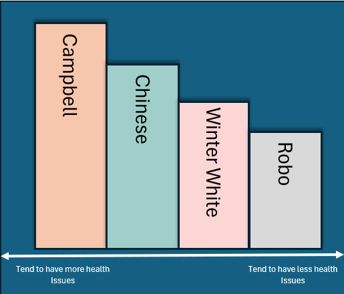
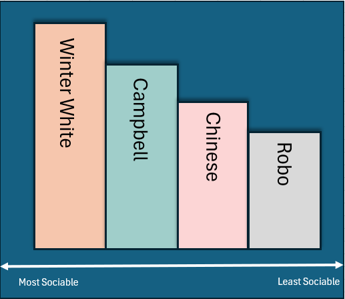
Graph 1:
1. Chinese Hamster: While active and curious, Chinese hamsters are not as energetically demanding as some other dwarf species. They do enjoy climbing and exploring but tend to have more moderate bursts of activity, especially when compared to the extremely lively Roborovskis.
2. Winter White Dwarf Hamster: Winter Whites are active, particularly during the evening and early night hours. They enjoy running on wheels and exploring their environment, but their activity levels are generally balanced, making them manageable for most owners.
3. Campbell’s Dwarf Hamster: Similar to Winter Whites in terms of activity, Campbell’s dwarf hamsters are known for their lively nature. They can be very active, especially if provided with ample space and stimulation. However, their activity can sometimes be less intense than the hyperactive Roborovskis.
4. Roborovski Dwarf Hamster: Known as the most active among the dwarf hamsters, Roborovskis are incredibly energetic and fast. They are often seen running on their wheels or darting around their enclosures at high speeds. Their constant motion and speed make them fascinating to watch but can also pose a challenge for handling and interaction.
Graph 2:
1. Campbell’s Dwarf Hamster: Often considered to have more health issues compared to other dwarf species, primarily due to their susceptibility to diabetes and the common occurrence of hybridization with Winter White hamsters, which can lead to genetic health problems.
2. Chinese Hamster: Generally healthy but can be prone to respiratory infections and, less commonly, diabetes. Their longer lifespan compared to some other dwarf species can also mean more potential for age-related diseases.
3. Winter White Dwarf Hamster: Relatively healthy but also susceptible to diabetes, especially in cases where they are hybridized with Campbell’s dwarf hamsters. Proper diet and care can mitigate many health issues.
4. Roborovski Dwarf Hamster: Tends to be the healthiest of the dwarf hamster species with fewer genetic diseases compared to others. They are less prone to diabetes and typically have fewer issues with obesity. However, their small size can make them more delicate, requiring careful handling to avoid injuries.
Graph 3:
1. Roborovski Dwarf Hamster: Least sociable towards human touch and can be skittish, making them more challenging to handle. They are, however, somewhat sociable with other Roborovskis if introduced properly and can coexist in pairs or small groups.
2. Chinese Hamster: More sociable than Roborovskis and can be handled more easily, but they still show a preference for being housed alone due to their territorial nature. They are better suited for owners who appreciate observing their pets rather than extensive handling.
3. Campbell’s Dwarf Hamster: Moderately sociable and can enjoy interaction with humans. They are known for recognizing their owner’s voice and can sometimes be handled comfortably. Campbell’s dwarf hamsters can live in pairs or small groups if introduced at a young age, though care should be taken to monitor for signs of aggression.
4. Winter White Dwarf Hamster: The most sociable among the dwarf hamster species, making them ideal for families and beginners. They are known for their friendliness towards humans and are more amenable to being handled. Winter Whites can also cohabitate with others of their kind, particularly well if they are introduced while they are young or are siblings.
Each species has unique traits and care needs, so their sociability can also depend on individual personalities and the environment in which they are kept.
